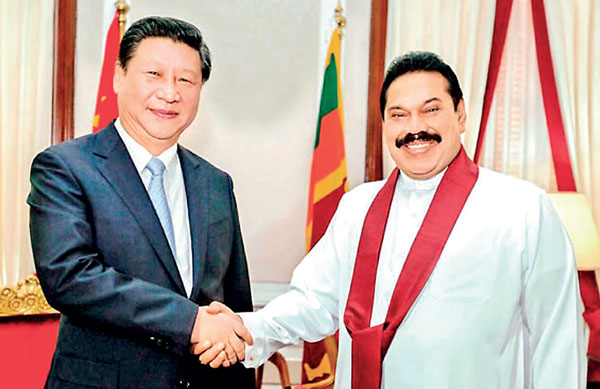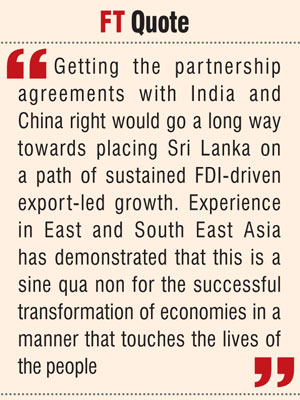
Thursday, 2nd October 2014
MirrorBusiness
Pathfinder Economic Alert
A winning combination
The combination of Sri Lanka’s geographical proximity and multifaceted ties with India which stretch back millennia, not least through Buddhism, and the close all-weather friendship with the People’s Republic of China, which spans over six decades, creates an unprecedented development opportunity.
Maximising commercial opportunities with both countries are not mutually-exclusive objectives. Sino-Indian economic ties were given a major boost during President Xi’s recent visit to India. This will inevitably generate new opportunities for Sri Lanka as well (see previous Pathfinder Alert 64 at www.pathfinderfoundation.org).
This poses the question as to what would be the most conducive framework for maximising the benefits from the proximity to India and the closeness to China. Getting the FTAs with the two countries right would act as a major engine for growth and development. It is noteworthy that Mexico has benefited greatly from the North American Free Trade Agreement (NAFTA) which links it both to the US and Canada.

A favourable framework
In this connection, it is very much in Sri Lanka’s interests to develop its economic relations with China and India in a holistic manner. In doing so, it is important not to ignore geopolitical realities. Sri Lanka is within India’s defence perimeter.
While each situation has very different specific circumstances, one can draw parallels between India’s strategic interest in Sri Lanka and the US interest in Cuba; Russia’s interest in Crimea; and China’s interest in Tibet. History is replete with examples of larger powers being very sensitive about strategic developments in their near neighbourhood.
Having said that, it is possible to manage these concerns while still maintaining considerable scope to pursue the twin objectives of maximising the benefits of Sri Lanka’s commercial relations with both China and India. As a relatively small country, we should focus on economic issues and balance various strategic interests to gain maximum commercial benefit.
As argued in the previous Economic Alert, ‘Sri Lanka-China FTA: The Jewel in the Crown,’ the FTAs with the two countries provide a useful framework for pursuing the maximisation of the commercial benefits of bilateral relations with these two countries. The FTA with India, which already exists, needs to be deepened and widened.
The scope and coverage of the Sino-Lanka FTA, which is currently being negotiated, should be ambitious in its scope and coverage. In this connection, the term ‘Comprehensive Economic Partnership Agreement’ has been demonised by a heady mix of a lack of information, misconceptions and a chauvinist mindset. One needs, therefore, to find a new terminology for the partnership agreements with China and India. More than the nomenclature, greater emphasis should be placed on the contours of these agreements.

Contours of economic partnerships with China and India
These agreements should cover trade in goods and services; investment; trade facilitation; trade remedies; technological cooperation; tourism; and human resources. As mentioned above, an FTA in Goods already exists with India which should be deepened and widened. The overall objective should be to negotiate positive and negative lists, which take into account the massive asymmetry between the Sri Lankan economy and those of India and China.
It is also necessary build in a dynamic perspective which goes beyond Sri Lanka’s current export capabilities and provides scope for new items, including through accessing regional, particularly Indian, supply chains. It is important that all stakeholders (government, business and trade experts) contribute towards formulating this dynamic view of Sri Lanka’s export potential.
Agreements on the trade in services are based on positive lists. Here again, Sri Lanka’s market access should be maximised while taking into account economic asymmetries. The current WTO commitments would constitute a useful starting point which can be built upon. The Government’s five hubs strategy (shipping, aviation, commercial, knowledge and energy) provides a good framework for establishing priorities in this area.
The full potential of gaining preferential access to a combined market to 2.5 billion people (China and India) cannot be realised without a dramatic increase in Foreign Direct Investment (FDI), mostly from these two countries.
Local capacity needs to be supported by external sourcing of capital, markets, technology, brands, processes and management skills in the way it has already happened in several successful East and South East Asian countries.
As explained in the previous Pathfinder Foundation (PF) Economic Alert, the FTAs with China and India can act as strong catalysts to boost FDI from these two countries to drive export growth. This would also help to address Sri Lanka’s two largest bilateral trade deficits. On many previous occasions, the PF has stressed the need for improving the investment climate.
The new Commercial Hub Legislation is an important advance. Domestic production capacity can be protected by adopting a negative list aligned to the country’s interests rather than vested interests. Ways and means of promoting Sri Lankan investment in China and India could also be explored. This could create opportunities for local companies to attain the scale necessary to become major regional players.
While it is important to negotiate favourable tariff reductions and more generous Rules of Origin, it is arguable that the biggest bang for the buck can be obtained through focusing on trade facilitation. Easing customs procedures; and addressing barriers related to sanitary and phytosanitary standards and technical barriers to trade (mutual recognition agreements can be very useful in this regard – with technical support for the relevant standard-setting authorities) can create a more propitious trading environment.
Given the massive asymmetry between the economies of China and India on the one hand and Sri Lanka on the other, trade remedies would need to be an important aspect of the negotiations on the partnership agreements with these two countries. Anti-dumping measures, countervailing duties and safeguard measures against import surges should all be part of the scope of the negotiations.
Technological upgrading was a key determinant of the success achieved by East and South East Asia. These countries have been very good at adopting and adapting new technologies. Sri Lanka has lagged behind in benefiting from FDI-driven technological upgrading. The negotiations on the two partnership agreements should seek to promote cooperation in this important area.
As mentioned before in previous PF articles, there is enormous potential to increase tourism from both China and India. The latter is already the largest source of tourists into Sri Lanka and Chinese arrivals are growing very rapidly. As tourism is the sixth pillar of the Government’s hub-based strategy, tourism promotion should be an important component of the partnership agreements with China and India.
Human resources are likely to be the binding constraint holding back an ambitious vision based on the partnership agreements with China and India. In the long-term, education, training, and skills development should be better aligned with the country’s dynamic international comparative advantage (particularly the five hubs + tourism strategy).
However, in the short-term it is inevitable that Sri Lanka will have to become much more open to skilled expatriate labour. The Government’s hub-based strategy would need to factor in recourse to expatriate expertise to fill local skill shortages. This needs to be factored into the negotiations of the two partnership agreements.
A recurring theme
Signing partnership agreements with China and India can only be the beginning of the story. Sri Lanka Incorporated (Government and business) would need to raise their game to a level not attained before to realise the full potential of these agreements. Previous PF articles have constantly referred to the need for consistent and predictable policies; sound macroeconomic fundamentals; and a more conducive business environment.
In this respect, it would be useful to appoint a High Level Task Force, ideally chaired by a leading private sector personality, to identify unnecessary bureaucratic regulations (de-bureaucratisation), including a streamlining of approval procedures. There have been previous such exercises which have yielded important insights into improving the investment climate. However, the benefits from these efforts were mitigated by the risk premium attached to the economy as a result of the civil conflict. No such drag exists today.
It is encouraging that the IMF is also now giving greater emphasis to the importance of FDI-driven export growth. This has been a recurring PF theme.
Getting the partnership agreements with India and China right would go a long way towards placing Sri Lanka on a path of sustained FDI-driven export-led growth. Experience in East and South East Asia has demonstrated that this is a sine qua non for the successful transformation of economies in a manner that touches the lives of the people.
(This is the 65th Economic Alert of Pathfinder Foundation. Readers’ comments are welcome at www.pathfinderfoundation.org.)
From: Daily Mirror. http://www.ft.lk/2014/10/01/getting-the-ftas-right-benefiting-from-both-china-and-india/




